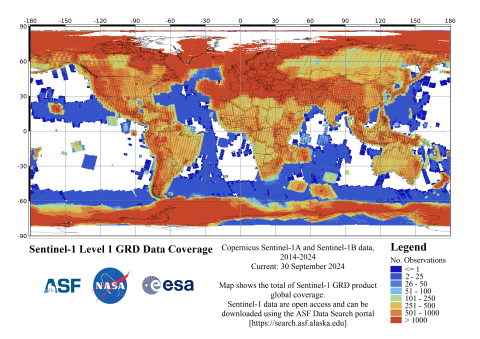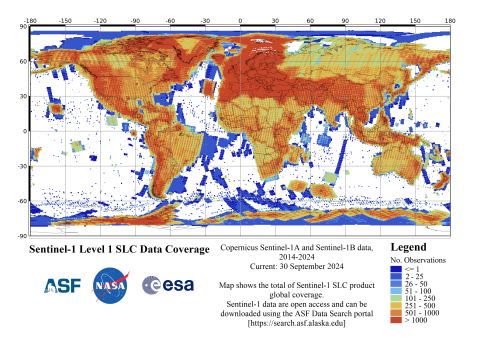Description
NASA’s provision of the complete ESA Sentinel-1 synthetic aperture radar (SAR) data archive through the ASF DAAC is by agreement between the U.S. State Department and the European Commission (EC). As part of the Earth-observation Copernicus program, the Sentinel mission will provide scientists with accurate, timely, and easily accessible information to help shape the future of our planet. Content on ASF’s Sentinel web pages is adapted from the ESA Sentinel-1 website.
In December 2021, an anomaly in the power supply of Sentinel-1B caused the SAR sensor to stop working. Attempts to restore power to the sensor failed, and the mission officially ended on August 3, 2022.
| Dataset Property | Strip Map (SM) mode | Interferometric Wide (IW) mode | Extra Wide (EW) mode | Wave (WV) mode |
|---|---|---|---|---|
| Temporal Coverage | 12 Days | 12 Days | 12 Days | 12 Days |
| Spatial Coverage | Global | Global | Global | Global |
| Center Frequency | C-band at 5.405 GHz | C-band at 5.405 GHz | C-band at 5.405 GHz | C-band at 5.405 GHz |
| Polarization | Single Polarization (HH or VV) Dual Polarization (HH+HV or VV+VH) | Single Polarization (HH or VV) Dual Polarization (HH+HV or VV+VH) | Single Polarization (HH or VV) Dual Polarization (HH+HV or VV+VH) | Single Polarization (HH or VV) Dual Polarization (HH+HV or VV+VH) |
| Spatial Resolution | 5 x 5 m | 5 x 20 m | 20 x 40 m | 5 x 5 m |
| Swath Width | 80 km | 250 km | 410 km | 100 km |
| Off-Nadir Angle | 18.3° to 46.8° | 29.1° to 46.0° | 18.9°° to 47.0° | 21.6° to 45.1° and 34.8° to 38.0° |
| File format | SAFE | SAFE | SAFE | SAFE |
| Provider | European Space Agency | European Space Agency | European Space Agency | European Space Agency |
| Date published: | 2014 | 2014 | 2014 | 2014 |
The loss of one of the Sentinel-1 satellites means that the frequency of observations and global coverage will be significantly reduced until the launch and commissioning of Sentinel-1C. This is predicted to be completed in the third quarter of 2023. Sentinel-1B will be deorbited at this time.
The Sentinel-1 constellation benefits numerous services, such as monitoring of Arctic sea-ice extent, routine sea-ice mapping, and surveillance of the marine environment. Applications include oil-spill monitoring and ship detection for maritime security; monitoring land-surface for motion risks; mapping for forest, water, and soil management; and mapping to support humanitarian aid and crisis situations.
Updated August 22, 2022
International Collaboration
Sentinel-1 is the result of close collaboration among ESA, the European Commission, industry, service providers, and data users.
NASA’s provision of the complete ESA Sentinel-1 SAR data archive through the ASF DAAC is by agreement between the U.S. State Department and the European Commission (EC). As part of the Earth-observation Copernicus program, the Sentinel mission will provide scientists with accurate, timely, and easily accessible information to help shape the future of our planet.
Content on ASF’s Sentinel web pages is adapted from ESA’s Sentinel website.
Sentinel-1 Frequently asked questions
| Question | Answer |
|---|---|
| What are the Sentinel-1 product types, and how are the data processed? | Sentinel-1 data products acquired in Stripmap, Interferometric Wide Swath, and Extra Wide Swath modes, generated by the Payload Data Ground Station, are distributed at three levels of processing: Level-0 (called RAW) , Level-1, and Level-2 Level-1 products can be one of two product types — either Single Look Complex (SLC) or Ground Range Detected (GRD). Level-2 Ocean (OCN) products can have different components available depending on the acquisition mode. Products are designated based on their acquisition mode, product type and, in the case of Level-1 GRD, resolution. All products are processed directly from the Level-0 product. Each mode can potentially generate Level-1 SLC, Level-1 GRD and Level-2 Ocean products. For Wave (WV) mode, the Level-0 and Level-1 products are not distributed. Level-2 Ocean Swell Spectra (OSW) component is not available from the TOPSAR modes. Learn about TOPSAR in the “Instrument” section under the “User Guide/Technical Information” tab. |
| What are the different Sentinel-1 beam modes? | Sentinel-1 satellites carry a C-band SAR instrument to provide a combined all-weather, day-and-night supply of imagery of Earth’s surface every six days. The four SAR modes — described in more detail in the “Image Quality” section under the “User Guide Technical Information” tab — are Extra Wide Swath, Interferometric Wide Swath, Stripmap, and Wave. |
| What is the naming convention for Sentinel-1 data? | Click to see a graphic for the naming convention for Sentinel-1 SAR products from the ASF DAAC. |
| I managed to get some Sentinel-1 files in the download queue, and I downloaded the .metalink, but I wasn’t able to download anything after opening the free download manager. Please advise. | You must be logged in to Vertex in order to download Sentinel-1 data from ASF. If you don’t already have a user account at ASF, please create one on Earthdata. |
| Is there a way to sort Sentinel-1 data in Vertex based on polarization, data type, etc.? | To filter by data product, use the drop-down menu titled at the bottom of the results column. Use the menu to select only those products you want added to your download queue. The bar, at the top of the results column, lets you filter your results by typing in keywords displayed in the granule description, such as path or flight direction. For more detailed sorting, use the and features, and add the results to your download queue. Click the button, and import the resulting file into a spreadsheet. Use the tools in your spreadsheet to sort the metadata — for example, by polarization. Copy and paste the resulting granule names into the window to the left of the map and click. Find additional Vertex help through the tab at the top left of the page. |
| Can I search for Sentinel-1 data over specific areas? | Use the geographic search option in the Vertex Data Portal to identify your area of interest and download Sentinel-1 products available from ASF DAAC. |
| How are Sentinel-1 data formatted? | Sentinel-1 data products are distributed using a Sentinel-specific variation of the Standard Archive Format for Europe (SAFE) format specification. The SAFE format has been designed to act as a common format for archiving and conveying data within ESA Earth Observation archiving facilities. The format wraps a folder containing image data in a binary data format and product metadata in XML. This flexibility allows the format to be scalable enough to represent all levels of Sentinel-1 products. A Sentinel-1 product refers to a directory folder that contains a collection of information. It includes:
|
| Why is the Sentinel-1 file I downloaded failing with a “path too long” error? | The default Windows file extraction utility will often fail because of long Sentinel-1 filenames. The open-source utility 7-Zip can be used to extract the .zip files downloaded from ASF and ESA. |
| Why are there stripes running across my Sentinel-1 EW and IW images? | These beam modes incorporate an acquisition technique (TOPSAR) that produces wide swaths from multiple sub-swaths, or bands, acquired in the direction the satellite is moving. This can create “seams” that are more noticeable in cross-polarized images (HV and VH). IW is acquired using three sub-swaths and EW five sub-swaths. Find more information in the “Instrument” and “Image Quality” sections under the “User Guide/Technical Information” tab. |
| Why do some Sentinel-1 images have stepped ends? | Stepped ends, as in the image to the right, are an artifact of the multi-beam scanning technology of TOPSAR and the way that ESA “slices” a data take into discrete, manageable units. See the “Image Quality” section under the “User Guide Technical Information” tab. |
| Why are some thumbnails and browse images in color and some in grayscale? | Single polarization (HH, VV) images are in grayscale, while dual polarization (HH/HV, VV/VH) images have had color assigned to each polarization channel. |
| Why doesn’t the Sentinel-1 browse image always orient the same direction as the granule outline rendered on the Vertex map? | The Sentinel-1A browse is a geocoded jpeg image displayed in a polar stereo map projection at latitudes above 65° north and south. The Vertex map always displays a granule in a Mercator projection. The browse image below is also an example of stepping (question #10). For more information on image artifacts and anomalies see the “Image Quality” section under the “User Guide/Technical Information” tab. |
| Why are there differences in Sentinel-1 image size between granules in the same beam mode, same swath? | The European Space Agency (ESA) uses slices instead of frames to divide a Sentinel-1 datatake into more manageable units, without any overlap or duplicated lines between slices. Stripmap and Interferometric Wide Swath slices consist of approximately 25 seconds of acquisition, and Extra Wide Swath slices consist of approximately 60 seconds. Each band within a product slice is kept to under 2 GB in size. Depending on the terrain being imaged, slices in the same datatake can have different dimensions in the azimuth direction. Find more information in the “Image Quality” section under the “User Guide/Technical Information” tab. |
| Why does the Alaska Satellite Facility (ASF) use frames for Sentinel-1 data when the European Space Agency (ESA) does not? | ASF DAAC assigns frames to Sentinel-1 product slices that refer to the same point temporally and geographically. In Vertex, search results then display all the products available over a point and time instead of listing the products for the same point individually. For example, a single Sentinel-1 slice can produce RAW, SLC, GRD and OCN products. ASF DAAC uses the internally generated frame number to group these products into a single Vertex search result and to create InSAR stacks or stacks used to color code Vertex results on the map to indicate approximate quantity of repeating observations with the same relative orbit and frame number. |
| Why does ESA have some Sentinel-1 data products that are missing from ASF? | This situation can happen when ESA just released new data and ASF DAAC is still waiting to get the product, or when ESA has processed a scene multiple times. In the latter case, ASF DAAC only keeps the most recent copy of each product type, but ESA may keep older copies available for distribution. If you have a specific product that does not seem to fit either of these two possibilities, please contact ASF DAAC through uso@alaska.edu. |
| Why do some of the Sentinel-1 granules in my Vertex search results have no thumbnail and browse images? | ASF DAAC generates thumbnail and browse images from the geocoded GRD product produced by the European Space Agency (ESA). If a granule in Vertex is missing a thumbnail and browse image, ASF has not received the GRD product yet, and only RAW, SLC or OCN products are currently available to download. Note: OCN (Wave mode) products never have browse or thumbnail images available. |
| Can I request Sentinel-1 data acquisitions from the European Space Agency (ESA)? | This ability is currently not available to individual researchers. Acquisition requests are determined by the requirements of the Copernicus program and ESA/EU member states. ESA does make upcoming acquisition planning available to download and view in Google Earth. More information about ESA’s background planning strategy is available on the ESA Sentinel-1 Observation Scenario web page. |
Product Summary
Citation
Citation is critically important for dataset documentation and discovery. This dataset is openly shared, without restriction, in accordance with the EOSDIS Data Use Policy.
Strengths and Limitations
In December 2021, an anomaly in the power supply of Sentinel-1B caused the SAR sensor to stop working. Attempts to restore power to the sensor failed, and the mission officially ended on August 3, 2022.





